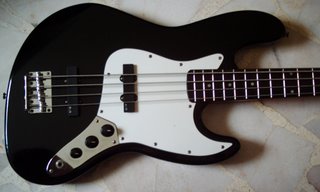 Buying a Bass
Buying a BassHi,
You have just decided to learn bass because your band needs one or you want to learn a new instrument, inspired by some bass guru or many other reasons.
I will share with you some
basic knowledge to give you a quick start on buying a bass guitar.
Yes, it is not a myth that if you want to improve your skills, you will need to invest buying a bass guitar and practise with it.
There are bass guitars with different settings and different number of strings available in the market.
Beginners can choose to start with a
4 string bass with basic settings first (price ranging $180-300) and as you progress and know more about what character of sound you like and etc, than get a better one. Common tuning for 4 string bass starting from the thickest string,
E A D G. Some people want to start with a 5 string bass. No problem.
You can also start with a relatively decent one (good wood, with preamp (bass and treble and some with mid), price ranging $550 and above) and make sure you make good use of it.
5 string bass has an additional
Low B right on top of the
Low E string so you don't need to play too much of open E giving you more control and wider range of sound and etc.
6 String bass has an additional
Low B same as 5 string but with additional High C string below of the G string.
Let's not talk about 8 strings and above basses at this stage of learning.
Have you wonder why some basses cost Less than $200 and some cost more than $2000?
Some of the reasons I could think of are:
a.
Branding (signature bass or famous basses cost more)
b.
Type of wood (e.g Bubinga, Ovangkol, Swash ash and etc)
c.
Type of Electronics (i.e. brand of pickup and preamps, e.g EMG, Bartolini, Seymour Duncan)
d.
Country of manufacturing ( Some countries' labour fee is lower hence the bass is cheaper but that does not meant lower quality)
e.
Import and export fee ( i.e. Shipping or air courier fee and the company that sold you the bass need to earn some "risk" money too)
f.
Bass neck connection ( neck thru usually more expensive than bolt on. Also more expensive when you need to adjust the neck action)
The character of the bass sound produce depend on the type of wood used for the bass body and neck, electronic set up, your playing and the type of strings used.
To know more about bass wood please visit www.warmoth.com (custom made bass website)
Different type of pickups will give you different character of sound. Passive and Active (with battery) pickups also provide different dynamics. Some bass can switch from passive to active.
Below are some examples of bass pickup in the market.
a.
Jazz pickup (Single coil)
b.
Humbuck ( double coil)
c.
P-bass Pickup (spilt humbuck )
d.
P-J Pickup ( Single + spilt humbuck)
e.
Piezo pickup ( very sensitive - check TRB 5PII for example)
f.
Jazz Humbuck ( Single + Double coil)
Two common type of Bass strings.
a.
Roundwound strings - Bright sound, good for slapping and tapping. ( I use gauge 40 for my G string because I like to do slap and pop. Most people use 45 - Marcus miller also)
b.
Flatwound strings - more mellow sound. Some use it for Jazz and slow rock.
When you try a bass, make sure you are comfortable with the feel and sound produce. The type of bass amp and other gadgets will come into the picture next time.
Buy something you are comfortable with and match your budget. Don't just go for brand.
You can check out shops at Peninsula plaza, Yamaha and many other places. You might want to consider buying a second-hand bass. Check out
Luther's Music website and Soft.com.sgCan also email bernard from Trader's Green - trdrsgrn@singnet.com.sg ( Sandberg bass)
Don't do impulse buying. Try it first, It's free. Ask advise from forum or friends who are more experience.
Welcome to the world of Bass!
Cheers,
Ben







